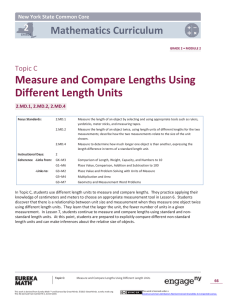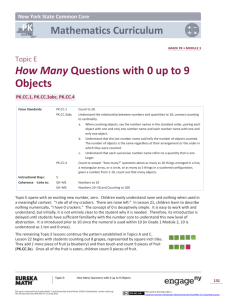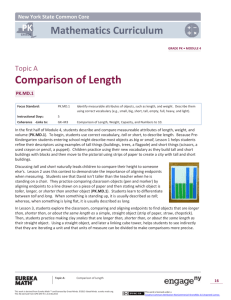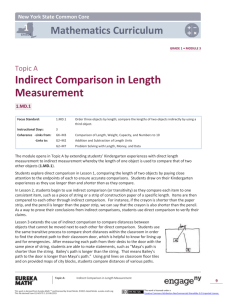Lesson 1 - EngageNY
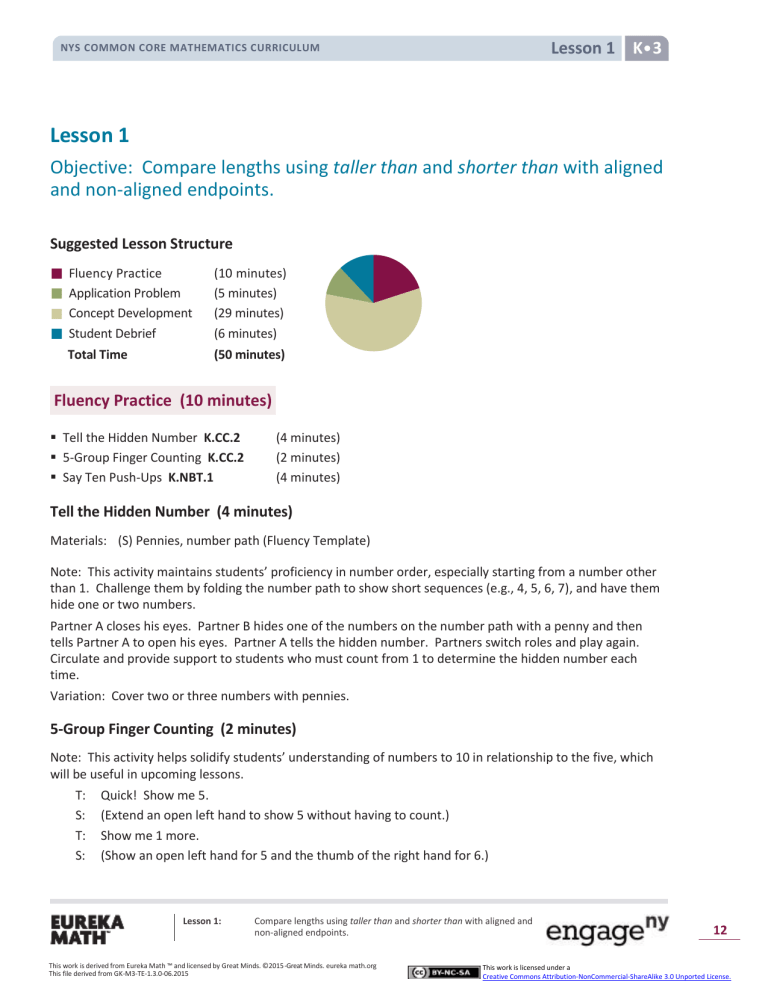
NYS COMMON CORE MATHEMATICS CURRICULUM
Lesson 1 K 3
Lesson 1
Objective: Compare lengths using taller than and shorter than with aligned and non-aligned endpoints.
Suggested Lesson Structure
(10 minutes)
(5 minutes)
(29 minutes)
(6 minutes)
Total Time (50 minutes)
Fluency Practice (10 minutes)
Tell the Hidden Number K.CC.2
5-Group Finger Counting K.CC.2
Say Ten Push-Ups K.NBT.1
(4 minutes)
(2 minutes)
(4 minutes)
Tell the Hidden Number (4 minutes)
Materials: (S) Pennies, number path (Fluency Template)
Note: This activity maintains students’ proficiency in number order, especially starting from a number other than 1. Challenge them by folding the number path to show short sequences (e.g., 4, 5, 6, 7), and have them hide one or two numbers.
Partner A closes his eyes. Partner B hides one of the numbers on the number path with a penny and then tells Partner A to open his eyes. Partner A tells the hidden number. Partners switch roles and play again.
Circulate and provide support to students who must count from 1 to determine the hidden number each time.
Variation: Cover two or three numbers with pennies.
5-Group Finger Counting (2 minutes)
Note: This activity helps solidify students’ understanding of numbers to 10 in relationship to the five, which will be useful in upcoming lessons.
T: Quick! Show me 5.
S: (Extend an open left hand to show 5 without having to count.)
T: Show me 1 more.
S: (Show an open left hand for 5 and the thumb of the right hand for 6.)
Lesson 1: Compare lengths using taller than and shorter than with aligned and non-aligned endpoints.
This work is derived from Eureka Math ™ and licensed by Great Minds. ©2015 -Great Minds. eureka math.org
This file derived from GK-M3-TE-1.3.0-06.2015
12
This work is licensed under a
Creative Commons Attribution-NonCommercial-ShareAlike 3.0 Unported License.
NYS COMMON CORE MATHEMATICS CURRICULUM
Lesson 1 K 3
T: We can count from 5 like this: 5 (push out the left hand), 1 more (push out the thumb of the right hand) is… (push both the left hand and the thumb of the right hand) 6. Try it with me. Ready?
S: 5 (push out the left hand), 1 more (push out the thumb of the right hand) is… (push both the left hand and the thumb of the right hand) 6.
T: Stay there at 6. Now, show me 1 more.
S: (Show an open left hand for 5 and the thumb and the index finger of the right hand for 7.)
T: How many fingers are you showing on your left hand?
S: 5.
T: And your right hand?
S: 2.
T: How many fingers are you showing in all?
S: 7.
T: So, this time, we’ll say 5 (push out the left hand), 2 more (push out the thumb and index finger of the right hand) is… (push out both the left hand and the thumb and index finger of the right hand) 7. Try it with me. Ready?
S: 5 (push out the left hand), 2 more (push out the thumb and index finger of the right hand) is… (push out both the left hand and the thumb and index finger of the right hand) 7.
Continue to 10 if students are ready, but there is no need to rush—this is a challenging counting activity. As students begin to note the pattern, steadily remove the scaffold until they can state the relationship to the 5group without guidance. It would be better for students to achieve mastery to 7 than to mimic the teacher to
10.
Say Ten Push-Ups (4 minutes)
Note: This activity extends students’ understanding of numbers to 10 in anticipation of working with teen numbers. Some students may already know how to say the numbers the conventional way. Do not discourage them from making that connection, but perhaps encourage them to say the numbers conventionally in their mind so as to not confuse others.
T: You’ve gotten so good at counting to ten. It’s time to start counting higher! Next is ten 1. Repeat, please.
S: Ten 1.
T: We can show it on our hands like this: ten (push out both hands, palms out, as if doing a push-up exercise in the air, and then pause with closed fists close to body) 1 (push out the right hand pinky finger). It’s your turn.
Ready?
S: Ten (push out both hands as if doing a push-up exercise in the air) and
(closed fists, close to body) 1 (push out the left hand pinky finger).
T: Very good. Next is ten (push out both hands as if doing a push-up exercise in the air) and (closed fists, close to body) 2 (push out the right hand pinky and ring fingers). It’s your turn. Ready?
S: Ten (push out both hands as if doing a push-up exercise in the air) and
(closed fists, close to body) 2 (push out the left hand pinky and ring fingers).
Ten and
4
Lesson 1: Compare lengths using taller than and shorter than with aligned and non-aligned endpoints.
This work is derived from Eureka Math ™ and licensed by Great Minds. ©2015 -Great Minds. eureka math.org
This file derived from GK-M3-TE-1.3.0-06.2015
13
This work is licensed under a
Creative Commons Attribution-NonCommercial-ShareAlike 3.0 Unported License.
NYS COMMON CORE MATHEMATICS CURRICULUM
Lesson 1 K 3
T: Ten (push out both hands as if doing a push-up exercise in the air) and (closed fists, close to body) 3
(push out the right hand pinky, ring, and middle fingers). It’s your turn. Ready?
Continue a few more times or until students can count and show the number on their hands fluently from ten to ten 3. In the next lesson, this activity will be extended to ten 5. Consider continuing to ten 5 now if students are ready, as they may catch on to the pattern quickly.
Application Problem (5 minutes)
Materials: (T) Indicated photos, heavy book, piece of ribbon 1 meter long
Setup: Show students a set of photos, one of a skyscraper contrasted with a one-story building.
T: With your partner, look at the photos of the buildings. Talk about how they are the same and how they are different. What do you notice?
S: One is bigger than the other.
T: When you compare and say it is bigger, let’s think about what you mean. (After each question, allow students to have a lively, brief discussion.)
T: Do you mean that it is heavier, like this book is heavier than this ribbon? (Dramatize the weight of the book and ribbon.)
T: Do you mean that it is longer, like this ribbon is longer than this book? (Dramatize the length of the ribbon.)
T: Do you mean it takes up more space, like this book takes up more space than this ribbon when it is all squished together? (Dramatize the volume of the book and ribbon.)
T: Do you mean to compare the number of things, like the number of books and ribbons? (Dramatize a count.)
NOTES ON
MULTIPLE MEANS
OF ACTION AND
EXPRESSION:
The teacher can help students who are below grade level practice the differences between the concepts of
taller than and shorter than by using interactive technology, such as the game found at the website: http://pbskids.org/clifford/games/meas uring_up.html.
T: So, we can compare things in different ways! Today, let’s compare by thinking about how much longer or shorter one thing is than another thing. (Dramatize.)
Concept Development (29 minutes)
Materials: (T) 2 chairs, 2 different lengths of string, 2 pencils of different lengths (S) 2 strips of paper (a longer blue one and a shorter red one)
T: We are going to have a magic show! Student A, please come stand by me. Class, what do you notice about our heights?
S: You are bigger.
Lesson 1: Compare lengths using taller than and shorter than with aligned and non-aligned endpoints.
This work is derived from Eureka Math ™ and licensed by Great Minds. ©2015 -Great Minds. eureka math.org
This file derived from GK-M3-TE-1.3.0-06.2015
14
This work is licensed under a
Creative Commons Attribution-NonCommercial-ShareAlike 3.0 Unported License.
NYS COMMON CORE MATHEMATICS CURRICULUM
Lesson 1 K 3
MP.6
T: Yes, I am taller than Student A. We say that Student A is shorter than I am. Now, watch my magic.
Abracadabra! (Pull out two chairs. Sit on one chair, and ask Student A to stand on the other.)
T: It’s magic! Isn’t Student A taller than I am now?
S: No. She’s standing on the chair!
T: So, even though her head is above mine right now, am I still taller than Student A?
S: Yes!
T: Hmmm. Thanks anyway, Student A.
T: Student B, could you please come help me? (Hand Student B two pieces of string of differing lengths, and have the student hold them up for class observation.)
T: Student B, what do you notice about the strings?
S: This one is longer!
T: This string is longer than that one. Abracadabra! (Take longer string, and fold it several times to make it shorter than the other. Hand it back to the student.) Now, it is shorter than the other. It’s magic!
S: No, it isn’t! You just crumpled it up, but it is still longer.
T: Oh well. Thank you, Student B.
T: I have two pencils. (Show students pencils of differing lengths.) This pencil is shorter than the other one. Now, close your eyes. (Place the pencils in your fist so that they appear to be equal.)
Abracadabra!
T: Look at the pencils now. They are the same length! It’s magic! (Varied responses.)
T: Student C, come look at my pencils, and tell the class what you see. (Have Student C observe the pencils.)
S: They aren’t the same. You were hiding the bottoms! The bottoms have to be even. This one is really longer.
T: You are right. The endpoints of the pencils need to be in the same place for us to compare them fairly. Now, you will get a chance to be the magicians. You and your partner will have two strips of paper. Compare to see which one is longer.
S: The blue one.
T: With your partner, see if you can find a way to make the red one look longer than the blue one.
(Allow students time to arrange the strips and experiment.) What happens if you line up the ends of the strips with the edge of your desk?
S: Now, they start in the same place. We can see that the blue one really is longer! That is the fair way to do it.
T: This reminds me of the number work we did with counters. Remember, even when we moved our counters around in different ways, we still had the same number of things. How is that similar to what you just saw?
S: Even if you move things around, they are still just as tall as they were before. (Guide students to realize that the attribute of length is conserved regardless of orientation or endpoint alignment.
Encourage them to articulate the necessity of accurate alignment.)
T: Now, we will think about taller than and shorter than while we look at our Problem Set.
Lesson 1: Compare lengths using taller than and shorter than with aligned and non-aligned endpoints.
This work is derived from Eureka Math ™ and licensed by Great Minds. ©2015 -Great Minds. eureka math.org
This file derived from GK-M3-TE-1.3.0-06.2015
15
This work is licensed under a
Creative Commons Attribution-NonCommercial-ShareAlike 3.0 Unported License.
NYS COMMON CORE MATHEMATICS CURRICULUM
Lesson 1 K 3
Problem Set (10 minutes)
Students should do their personal best to complete the
Problem Set within the allotted time.
For some classes, it may be appropriate to modify the assignment by specifying which problems students should work on first. With this option, let the purposeful sequencing of the Problem Set guide your selections so that problems continue to be scaffolded. Balance word problems with other problem types to ensure a range of practice. Consider assigning incomplete problems for homework or at another time during the day.
Student Debrief (6 minutes)
Lesson Objective: Compare lengths using taller than and
shorter than with aligned and non-aligned endpoints.
The Student Debrief is intended to invite reflection and active processing of the total lesson experience.
Invite students to review their solutions for the Problem
Set. They should check work by comparing answers with a partner before going over answers as a class. Look for misconceptions or misunderstandings that can be addressed in the Debrief. Guide students in a conversation to debrief the Problem Set and process the lesson.
Any combination of the questions below may be used to lead the discussion.
What did you notice when we were looking at the pencils? (Note: Guide discussion to focus on the importance of proper endpoint alignment.)
What did you notice when we were comparing the strings? (Note: Guide discussion to focus on conservation of length with respect to orientation and movement.)
How did you know which paper strip on your
Problem Set was longer than the other?
How did you know which paper strip on your
Problem Set was shorter than the other?
Explain to your partner how you were able to draw the flower taller than the vase. Did your partner think the same way?
Lesson 1: Compare lengths using taller than and shorter than with aligned and non-aligned endpoints.
This work is derived from Eureka Math ™ and licensed by Great Minds. ©2015 -Great Minds. eureka math.org
This file derived from GK-M3-TE-1.3.0-06.2015
16
This work is licensed under a
Creative Commons Attribution-NonCommercial-ShareAlike 3.0 Unported License.
NYS COMMON CORE MATHEMATICS CURRICULUM
Lesson 1 K 3
When we started our lesson, we thought about how we might compare things. What were we comparing today? How heavy something is, how long something is, how many of something there are, or how much space something takes up?
Homework
Homework at the K–1 level is not a convention in all schools. In this curriculum, homework is an opportunity for additional practice of the content from the day's lesson. The teacher is encouraged, with the support of parents, administrators, and colleagues, to discern the appropriate use of homework for his or her students. Fluency exercises can also be considered as an alternative homework assignment.
Lesson 1: Compare lengths using taller than and shorter than with aligned and non-aligned endpoints.
This work is derived from Eureka Math ™ and licensed by Great Minds. ©2015 -Great Minds. eureka math.org
This file derived from GK-M3-TE-1.3.0-06.2015
17
This work is licensed under a
Creative Commons Attribution-NonCommercial-ShareAlike 3.0 Unported License.
NYS COMMON CORE MATHEMATICS CURRICULUM
Lesson 1 Problem Set K 3
Name Date
For each pair, circle the longer one. Imagine the paper strips are lying flat on a table.
Draw a flower that is taller than the vase.
Draw a tree that is taller than the house.
Lesson 1: Compare lengths using taller than and shorter than with aligned and non-aligned endpoints.
This work is derived from Eureka Math ™ and licensed by Great Minds. ©2015 -Great Minds. eureka math.org
This file derived from GK-M3-TE-1.3.0-06.2015
18
This work is licensed under a
Creative Commons Attribution-NonCommercial-ShareAlike 3.0 Unported License.
NYS COMMON CORE MATHEMATICS CURRICULUM
For each pair, circle the shorter one.
Lesson 1 Problem Set K 3
Draw a bookmark that is shorter than this book.
Draw a crayon that is shorter than this pencil.
Lesson 1: Compare lengths using taller than and shorter than with aligned and non-aligned endpoints.
This work is derived from Eureka Math ™ and licensed by Great Minds. ©2015 -Great Minds. eureka math.org
This file derived from GK-M3-TE-1.3.0-06.2015
19
This work is licensed under a
Creative Commons Attribution-NonCommercial-ShareAlike 3.0 Unported License.
NYS COMMON CORE MATHEMATICS CURRICULUM
Lesson 1 Homework K 3
Name Date
Draw 3 more flowers that are shorter than these flowers.
Count how many flowers you have now. Write the number in the box.
Draw 2 more ladybugs that are taller than these ladybugs.
Count how many ladybugs you have now. Write the number in the box.
On the back of your paper, draw something that is taller than you.
Draw something that is shorter than a flagpole.
Lesson 1: Compare lengths using taller than and shorter than with aligned and non-aligned endpoints.
This work is derived from Eureka Math ™ and licensed by Great Minds. ©2015 -Great Minds. eureka math.org
This file derived from GK-M3-TE-1.3.0-06.2015
20
This work is licensed under a
Creative Commons Attribution-NonCommercial-ShareAlike 3.0 Unported License.
NYS COMMON CORE MATHEMATICS CURRICULUM
Lesson 1 Fluency Template K 3
1 2 3 4 5 6 7 8 9 10
1 2 3 4 5 6 7 8 9 10
1 2 3 4 5 6 7 8 9 10
1 2 3 4 5 6 7 8 9 10
1 2 3 4 5 6 7 8 9 10
1 2 3 4 5 6 7 8 9 10
number path
Lesson 1: Compare lengths using taller than and shorter than with aligned and non-aligned endpoints.
This work is derived from Eureka Math ™ and licensed by Great Minds. ©2015 -Great Minds. eureka math.org
This file derived from GK-M3-TE-1.3.0-06.2015
21
This work is licensed under a
Creative Commons Attribution-NonCommercial-ShareAlike 3.0 Unported License.

